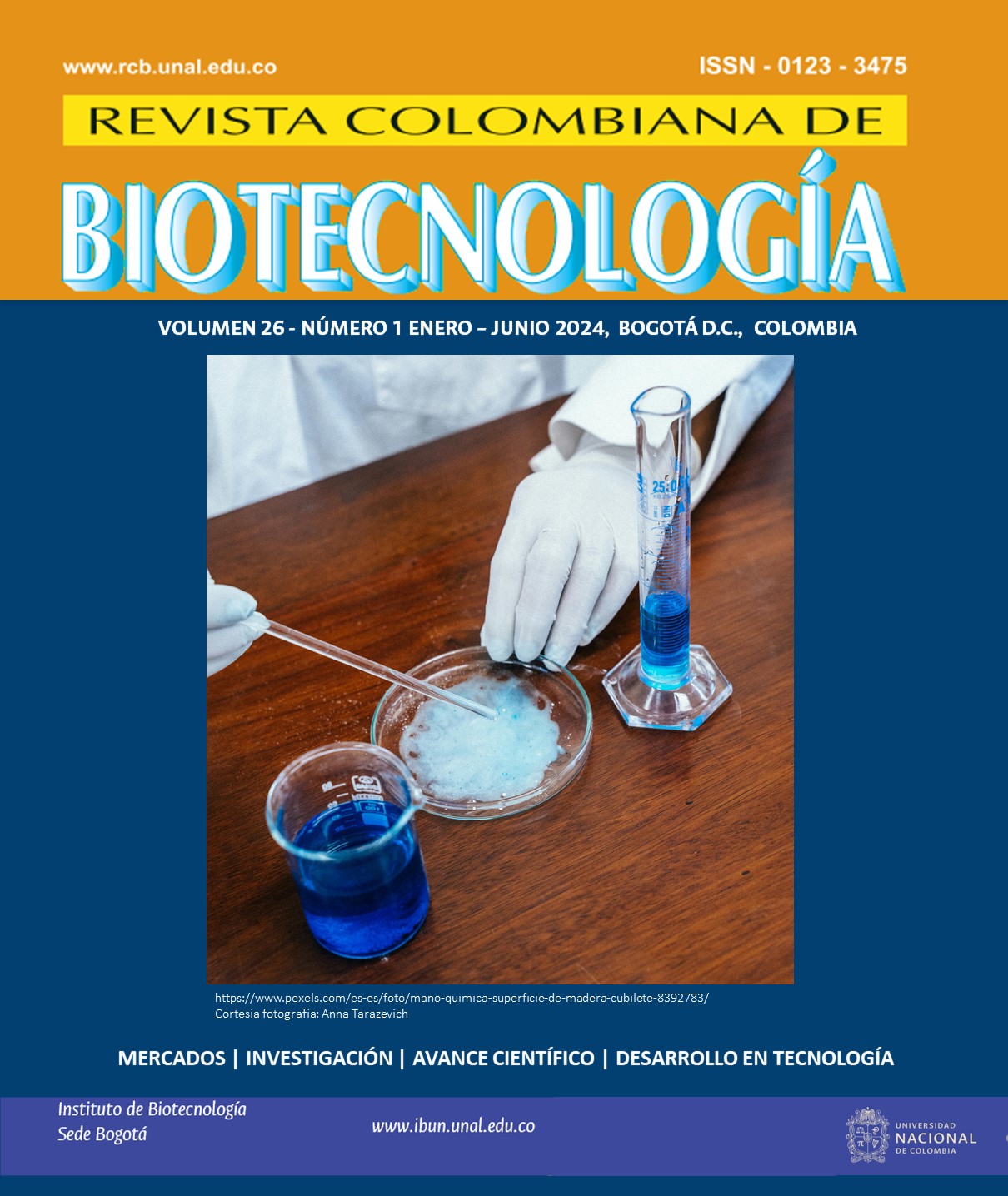Efectos agudos de fenantreno y benzo[a]pireno en Aequidens metae (Pisces: Cichlidae)
Acute effects of phenanthrene and benzo[a]pyrene in Aequidens metae (Pisces: Cichlidae)
DOI:
https://doi.org/10.15446/rev.colomb.biote.v26n1.101879Palabras clave:
Actividad EROD, Genotoxicidad, Hidrocarburos Aromáticos Policiclícos, Histometría, Micronúcleos (es)EROD activity, Genotoxicity, Polycyclic aromatic hydrocarbons, Histometry, Micronucleus (en)
Descargas
Los organismos acuáticos pueden estar expuestos a efluentes industriales que con frecuencia contienen hidrocarburos aromáticos policíclicos (HAPs). Muchos de sus efectos pueden pasar desapercibidos, por lo que, la valoración de biomarcadores permite evaluar los riesgos que pueden generar daños a la salud asociados a su metabolismo. Se evaluaron distintos biomarcadores en Aequidens metae expuesto a HAPs. Se utilizaron adultos de 6,3 ± 1,2 cm y 5,5 ± 1,6 g. Los peces fueron expuestos vía intraperitoneal a 1, 10 y 50 μg/g de fenantreno (PHE), 0,1, 1; a 10 μg/g de benzo[a]Pireno (B[a]P) y 50 μg/g β-naftoflavona. Se realizaron muestreos a los 0, 3 y 10 días. Se tomaron muestras de hígado y sangre periférica para su procesamiento. Se evaluó la actividad 7-etoxiresorufina-O-deetilasa (EROD), histometría de hepatocitos y frecuencia de micronúcleos y otras anormalidades en sangre. Encontrando incremento en la actividad EROD al día 3 de exposición para B[a]P de 10 μg/g (11,82 ± 2,27 pmol/mg/min) y BNF (9,11 ± 3,04 pmol/mg/min) con relación al control negativo (p<0,05). También, se presentó respuesta tisular y genotóxica con PHE, B[a]P y BNF a las concentraciones medias y altas. Podemos concluir que, bajo las condiciones de este estudio, benzo[a]Pireno es un fuerte inductor que activa la vía de biotransformación de CYP1A en comparación a PHE, además que la actividad EROD, las anormalidades nucleares y las características histométricas de los hepatocitos son dependientes del tiempo de exposición, la concentración del HAP y de las características del inductor en A. metae.
Aquatic organisms may be exposed to industrial effluents that often contain polycyclic aromatic hydrocarbons (PAHs). Many of their effects may go unnoticed, therefore, the assessment of biomarkers allows the evaluation of the risks that may generate health damage associated with their metabolism. Different biomarkers were evaluated in Aequidens metae exposed to PAHs. Adults of 6,3 ± 1,2 cm and 5,5 ± 1,6 g were used. Fish were exposed intraperitoneally to 1, 10 and 50 μg/g phenanthrene (PHE), 0,1, 1; to 10 μg/g benzo[a]Pyrene (B[a]P) and 50 μg/g β-naphthoflavone. Sampling was performed at 0, 3 and 10 days. Liver and peripheral blood samples were taken for processing. 7-ethoxyresorufin-O-deethylase (EROD) activity, hepatocyte histometry and frequency of micronuclei and other abnormalities in blood were evaluated. We found an increase in EROD activity at day 3 of exposure for B[a]P of 10 μg/g (11,82 ± 2,27 pmol/mg/min) and BNF (9,11 ± 3,04 pmol/mg/min) in relation to the negative control (p<0.05). Also, tissue and genotoxic response was presented with PHE, B[a]P and BNF at medium and high concentrations. We can conclude that, under the conditions of this study, B[a]P is a strong inducer that activates the CYP1A biotransformation pathway compared to PHE, furthermore, EROD activity, nuclear abnormalities and histometric characteristics of hepatocytes dependent on exposure time, PAH concentration and the PAH characteristics in A. metae.
Referencias
Almeda, R., Wambaugh, Z., Wang, Z., Hyatt, C., Liu, Z., & Buskey, E. J. (2013). Interactions between Zooplankton and Crude Oil: Toxic Effects and Bioaccumulation of Polycyclic Aromatic Hydrocarbons. PLOS ONE, 8(6), e67212. doi:10.1371/journal.pone.0067212
Bacolod, E. T., Uno, S., Villamor, S. S., & Koyama, J. (2017). Oxidative stress and genotoxicity biomarker responses in tilapia (Oreochromis niloticus) exposed to environmental concentration of 1-nitropyrene. Marine Pollution Bulletin, 124(2), 786-791. doi:https://doi.org/10.1016/j.marpolbul.2017.01.077
Banni, M., Bouraoui, Z., Ghedira, J., Clerandeau, C., Guerbej, H., Narbonne, J. F., & Boussetta, H. (2009). Acute effects of benzo[a]pyrene on liver phase I and II enzymes, and DNA damage on sea bream Sparus aurata. Fish Physiology and Biochemistry, 35(2), 293-299. doi:10.1007/s10695-008-9210-9
Burke, M. D., & Mayer, R. T. (1974). Ethoxyresorufin: direct fluorimetric assay of a microsomal O-dealkylation which is preferentially inducible by 3-methylcholanthrene. Drug Metabolism and Disposition, 2(6), 583-588.
Calderón-Delgado, I. C., Mora-Solarte, D. A., & Velasco-Santamaría, Y. M. (2019). Physiological and enzymatic responses of Chlorella vulgaris exposed to produced water and its potential for bioremediation. Environmental Monitoring and Assessment, 191(6), 399. doi:10.1007/s10661-019-7519-8
Caramello, C., Cowper, C., Jorge, M., Pérez, J., & Jorge, L. (2019). Anormalidades morfológicas nucleares en hematíes del pez Prochilodus linneatus expuesto al clorpirifos. Revista veterinaria, 30(2), 64-72.
Carrasco, K. R., Tilbury, K. L., & Myers, M. S. (1990). Assessment of the Piscine Micronucleus Test as an in situ Biological indicator of Chemical Contaminant Effects. Canadian Journal of Fisheries and Aquatic Sciences, 47(11), 2123-2136. doi:10.1139/f90-237
Corredor-Santamaría, W., Mora-Romero, C. C., Escobar-Buitrago, P. S., Cruz-Casallas, P. E., & Velasco-Santamaría, Y. M. (2012). Inducción de micronúcleos y otras anormalidades nucleares en Astyanax gr. bimaculatus (Pisces: Characidae) expuestas a fenantreno. Orinoquia, 16, 237-247.
Corredor-Santamaría, W., Mora-Solarte, D. A., Arbeli, Z., Navas, J. M., & Velasco-Santamaría, Y. M. (2021). Liver biomarkers response of the neotropical fish Aequidens metae to environmental stressors associated with the oil industry. Heliyon, 7(7), e07458.
Corredor-Santamaría, W., Torres-Tabares, A., & Velasco-Santamaría, Y. M. (2019). Biochemical and histological alterations in Aequidens metae (Pisces, Cichlidae) and Astyanax gr. bimaculatus (Pisces, Characidae) as indicators of river pollution. Science of the Total Environment, 692, 1234-1241. doi:https://doi.org/10.1016/j.scitotenv.2019.07.187
Correia, A. D., Gonçalves, R., Scholze, M., Ferreira, M., & Henriques, M. A.-R. (2007). Biochemical and behavioral responses in gilthead seabream (Sparus aurata) to phenanthrene. Journal of Experimental Marine Biology and Ecology, 347(1), 109-122. doi:https://doi.org/10.1016/j.jembe.2007.03.015
Costa, J., Ferreira, M., Rey-Salgueiro, L., & Reis-Henriques, M. A. (2011). Comparision of the waterborne and dietary routes of exposure on the effects of Benzo(a)pyrene on biotransformation pathways in Nile tilapia (Oreochromis niloticus). Chemosphere, 84(10), 1452-1460. doi:https://doi.org/10.1016/j.chemosphere.2011.04.046
DoNascimiento, C., Herrera Collazos, E., & Maldonado-Ocampo, J. A. (2019). Lista de especies de peces de agua dulce de Colombia/Checklist of the freshwater fishes of Colombia. Version 2.14. (Asociación Colombiana de Ictiólogos. Dataset/Checklist.
Esmaeilbeigi, M., Kalbassi, M. R., Seyedi, J., Tayemeh, M. B., & Moghaddam, J. A. (2021). Intra and extracellular effects of benzo [α] pyrene on liver, gill and blood of Caspian White fish (Rutilus frissi kutum): Cyto-genotoxicity and histopathology approach. Marine Pollution Bulletin, 163, 111942. doi:https://doi.org/10.1016/j.marpolbul.2020.111942
Gagnon, M. M., & Rawson, C. A. (2017). Bioindicator species for EROD activity measurements: A review with Australian fish as a case study. Ecological Indicators, 73, 166-180. doi:https://doi.org/10.1016/j.ecolind.2016.09.015
Grimard, C., Mangold-Döring, A., Schmitz, M., Alharbi, H., Jones, P. D., Giesy, J. P., . . . Brinkmann, M. (2020). In vitro-in vivo and cross-life stage extrapolation of uptake and biotransformation of benzo[a]pyrene in the fathead minnow (Pimephales promelas). Aquatic Toxicology, 228, 105616. doi:https://doi.org/10.1016/j.aquatox.2020.105616
Grisolia, C. K. (2002). A comparison between mouse and fish micronucleus test using cyclophosphamide, mitomycin C and various pesticides. Mutation Research/Genetic Toxicology and Environmental Mutagenesis, 518(2), 145-150. doi:https://doi.org/10.1016/S1383-5718(02)00086-4
Haritash, A. K., & Kaushik, C. P. (2009). Biodegradation aspects of Polycyclic Aromatic Hydrocarbons (PAHs): A review. Journal of Hazardous Materials, 169(1), 1-15. doi:https://doi.org/10.1016/j.jhazmat.2009.03.137
IDEAM. (2018). Instituto de Hidrología, Meteorología y Estudios Ambientales, Atlas climatológico de Colombia. Bogotá (Colombia).
Marcon, L., Thomé, R. G., Mounteer, A. H., Bazzoli, N., Rizzo, E., & Benjamin, L. d. A. (2017). Immunohistochemical, morphological and histometrical analyses of follicular development in Astyanax bimaculatus (Teleostei: Characidae) exposed to an organochlorine insecticide. Ecotoxicology and Environmental Safety, 143, 249-258. doi:https://doi.org/10.1016/j.ecoenv.2017.05.029
Peters, L., O'hara, S., & Livingstone, D. (1996). Benzo [a] pyrene metabolism and xenobiotic-stimulated reactive oxygen species generation by subcellular fraction of larvae of turbot (Scophthalmus maximus L.). Comparative Biochemistry and Physiology Part C: Pharmacology, Toxicology and Endocrinology, 114(3), 221-227.
Raibeemol, K. P., & Chitra, K. C. (2020). Induction of immunological, hormonal and histological alterations after sublethal exposure of chlorpyrifos in the freshwater fish, Pseudetroplus maculatus (Bloch, 1795). Fish & shellfish immunology, 102, 1-12. doi:https://doi.org/10.1016/j.fsi.2020.04.005
Sadauskas-Henrique, H., Duarte, R. M., Gagnon, M. M., & Almeida-Val, V. M. F. (2017). Validation of a suite of biomarkers of fish health in the tropical bioindicator species, tambaqui (Colossoma macropomum). Ecological Indicators, 73, 443-451. doi:https://doi.org/10.1016/j.ecolind.2016.10.010
Salvo, L. M., Severino, D., Silva de Assis, H. C., & da Silva, J. R. M. C. (2016). Photochemical degradation increases polycyclic aromatic hydrocarbon (PAH) toxicity to the grouper Epinephelus marginatus as assessed by multiple biomarkers. Chemosphere, 144, 540-547. doi:https://doi.org/10.1016/j.chemosphere.2015.09.013
Santana, M. S., Sandrini-Neto, L., Filipak Neto, F., Oliveira Ribeiro, C. A., Di Domenico, M., & Prodocimo, M. M. (2018). Biomarker responses in fish exposed to polycyclic aromatic hydrocarbons (PAHs): Systematic review and meta-analysis. Environmental Pollution, 242, 449-461. doi:https://doi.org/10.1016/j.envpol.2018.07.004
Santos, C., de Oliveira, M. T., Cólus, I. M. d. S., Sofia, S. H., & Martinez, C. B. d. R. (2018). Expression of cyp1a induced by benzo(A)pyrene and related biochemical and genotoxic biomarkers in the neotropical freshwater fish Prochilodus lineatus. Environmental Toxicology and Pharmacology, 61, 30-37. doi:https://doi.org/10.1016/j.etap.2018.05.008
Shirmohammadi, M., Salamat, N., Ronagh, M. T., Movahedinia, A., & Hamidian, G. (2018). Using cell apoptosis, micronuclei and immune alternations as biomarkers of phenanthrene exposure in yellowfin seabream (Acanthopagrus latus). Fish & shellfish immunology, 72, 37-47. doi:https://doi.org/10.1016/j.fsi.2017.10.039
Speight, J. (2020) Handbook of Industrial Hydrocarbon Processes.Sources of hydrocarbons. In: Speight JG (Second Edition). Boston (Estados Unidos) Gulf Professional Publishing, 45-93.
Valdehita, A., Fernández-Cruz, M. L., Torrent, F., Sericano, J. L., & Navas, J. M. (2012). Differences in the induction of cyp1A and related genes in cultured rainbow trout Oncorhynchus mykiss. Additional considerations for the use of EROD activity as a biomarker. Journal of Fish Biology, 81(1), 270-287. doi:https://doi.org/10.1111/j.1095-8649.2012.03338.x
van der Oost, R., Beyer, J., & Vermeulen, N. P. E. (2003). Fish bioaccumulation and biomarkers in environmental risk assessment: a review. Environmental Toxicology and Pharmacology, 13(2), 57-149. doi:https://doi.org/10.1016/S1382-6689(02)00126-6
Velasco-Santamaría, Y., Navarro-Martin, L. (2014). Clonación y secuenciación del gen de la aromatasa cerebral (cyp19a1b) y gonadal (cyp19a1a) en Aequidens metae como biomarcador de perturbación endocrina (Villavicencio,Colombia,2014).Memorias, Villavicencio (Colombia), 103.
Wolińska, L., Brzuzan, P., Woźny, M., Łuczyński, M. K., & Góra, M. (2013). CYP1A expression in liver and gills of roach (Rutilus rutilus) after waterborne exposure to two phenanthrene derivatives, 1-methylphenanthrene and 4-methylphenanthrene. Environmental Toxicology and Chemistry, 32(7), 1604-1610. doi:https://doi.org/10.1002/etc.2225
Wunderlich, A. C., Silva, R. J., Zica, É. O. P., Rebelo, M. F., Parente, T. E. M., & Vidal-Martínez, V. M. (2015). The influence of seasonality, fish size and reproductive status on EROD activity in Plagioscion squamosissimus: Implications for biomonitoring of tropical/subtropical reservoirs. Ecological Indicators, 58, 267-276. doi:https://doi.org/10.1016/j.ecolind.2015.05.063
Cómo citar
APA
ACM
ACS
ABNT
Chicago
Harvard
IEEE
MLA
Turabian
Vancouver
Descargar cita
Licencia

Esta obra está bajo una licencia internacional Creative Commons Atribución 4.0.
Esta es una revista de acceso abierto distribuida bajo los términos de la Licencia Creative Commons Atribución 4.0 Internacional (CC BY). Se permite el uso, distribución o reproducción en otros medios, siempre que se citen el autor(es) original y la revista, de conformidad con la práctica académica aceptada. El uso, distribución o reproducción está permitido desde que cumpla con estos términos.
Todo artículo sometido a la Revista debe estar acompañado de la carta de originalidad. DESCARGAR AQUI (español) (inglés).



















